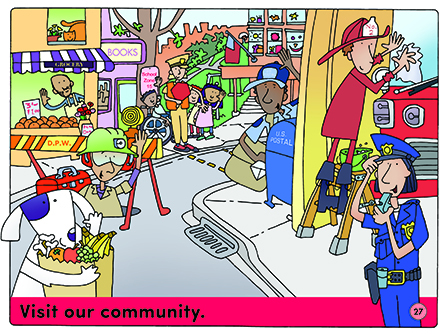Page 27 from

Every child lives within a community. Some children in your class might come from the same neighborhoods. Others might come from very different places. Some children may know their neighbors, and others may not. Encourage students to share stories about their neighborhoods, helping them learn more about where they live and where others live.
About the Picture Spot is leaving a corner grocery store, heading home with a bag full of healthful foods. On the way, he sees many people working in his neighborhood. Ask students what jobs they see people doing in the community. Ask why each job helps make the neighborhood a good place to be. Ask what job students would like to do to make their communities better places.
Major Concepts
- A community is a group of people who live and work together.
- People in communities can be friends and can take care of each other.
- Students can help make their communities good places to live.

Every child lives within a community. Some children in your class might come from the same neighborhoods. Others might come from very different places. Some children may know their neighbors, and others may not. Encourage students to share stories about their neighborhoods, helping them learn more about where they live and where others live.
About the Picture Spot is leaving a corner grocery store, heading home with a bag full of healthful foods. On the way, he sees many people working in his neighborhood. Ask students what jobs they see people doing in the community. Ask why each job helps make the neighborhood a good place to be. Ask what job students would like to do to make their communities better places.
Major Concepts
- A community is a group of people who live and work together.
- People in communities can be friends and can take care of each other.
- Students can help make their communities good places to live.